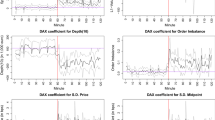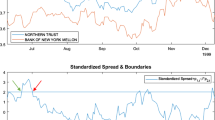Abstract
We consider a pure exchange economy, where for each good several trading institutions are available, only one of which is market-clearing. The other feasible trading institutions lead to rationing. To learn on which trading institutions to coordinate, traders follow behavioral rules of thumb that are based on the past performances of the trading institutions. Given the choice of institutions, market outcomes are determined by an equilibrium concept that allows for rationing. We find that full coordination on the market-clearing institutions without any rationing is a stochastically stable outcome, independently of the characteristics of the alternative available institutions. We also find, though, that coordination on certain other, non-market-clearing institutions with rationing can be stochastically stable.
Similar content being viewed by others
References
Allen, B.: Continuous Random Selections from the Utility Correspondence. CARESS Working Paper 85–25, University of Pennsylvania, Philadelphia, PA (1985)
Alós-Ferrer C.: Finite population dynamics and mixed equilibria. Int Game Theory Rev 5(3), 263–290 (2003)
Alós-Ferrer C., Ania A.B.: The evolutionary stability of perfectly competitive behavior. Econ Theory 26(3), 497–516 (2005)
Alós-Ferrer, C., Kirchsteiger, G.: Learning and Market Clearing. Mimeo (2008)
Alós-Ferrer, C., Netzer, N.: The Logit-response Dynamics. Mimeo (2007)
Dreze J.H.: Existence of an exchange equilibrium under price rigidities. Int Econ Rev 16(2), 301–320 (1975)
Ellison G.: Basins of attraction, long run stochastic stability, and the speed of step-by-step evolution. Rev Econ Stud 67, 17–45 (2000)
Faias M., Moreno-García E., Páscoa M.R.: Real indeterminacy of equilibria and manipulability. J Math Econ 37, 325–340 (2002)
Feller W.: An Introduction to Probability Theory and Its Applications, vol. I. Wiley, New York (1968)
Gerber A., Bettzüge M.O.: Evolutionary choice of markets. Econ Theory 30, 453–472 (2007)
Holt, C.: Industrial organization: a survey of laboratory research. In: Kagel, J., Roth, A. Handbook of Experimental Economics, Princeton: Princeton University Press (1995)
Kandori M., Mailath G., Rob R.: Learning, mutation, and long-run equilibria in games. Econometrica 61, 29–56 (1993)
Karlin S., Taylor H.M.: A First Course in Stochastic Processes, vol. 2. Academic Press, San Diego (1975)
Mas-Colell A., Nachbar J.: On the finiteness of the number of critical equilibria, with an application to random selections. J Math Econ 20, 397–409 (1991)
Moreno-García E.: Strategic equilibria with partially disposable withholdings. Int Game Theory Rev 8, 1–21 (2006)
Ockenfels A., Roth A.: Last-minute bidding and the rules for ending second-price auctions: evidence from eBay and Amazon on the Internet. Am Econ Rev 92, 1093–1103 (2002)
Postlewaite A.: Manipulation via endowments. Rev Econ Stud 46, 255–262 (1979)
Plott C.: Industrial organization theory and experimental economics. J Econ Lit 20, 1485–1587 (1982)
Schaffer M.E.: Evolutionarily stable strategies for a finite population and a variable contest size. J Theor Biol 132, 469–478 (1988)
Stahn H.: Monopolistic behaviors and general equilibrium: a generalization of Nikaido’s work. J Math Econ 32, 87–112 (1999)
Yi G.: Manipulation via withholding. Rev Econ Stud 58, 817–820 (1991)
Young P.: The evolution of conventions. Econometrica 61, 57–84 (1993)
Author information
Authors and Affiliations
Corresponding author
Additional information
We thank two very careful referees for useful comments which greatly improved the paper.
Rights and permissions
About this article
Cite this article
Alós-Ferrer, C., Kirchsteiger, G. General equilibrium and the emergence of (non)market clearing trading institutions. Econ Theory 44, 339–360 (2010). https://doi.org/10.1007/s00199-009-0466-9
Received:
Accepted:
Published:
Issue Date:
DOI: https://doi.org/10.1007/s00199-009-0466-9




